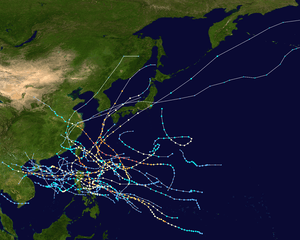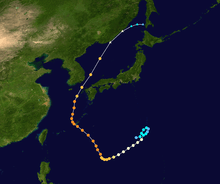1956 Pacific typhoon season
| |
| Season summary map |
| First system formed |
January 18, 1956 |
| Last system dissipated |
January 1, 1957 |
| Strongest storm |
Wanda – 910 hPa (mbar), 325 km/h (200 mph) |
| Total depressions |
39 |
| Total storms |
26 |
| Typhoons |
18 |
| Super typhoons |
5 |
| Total fatalities |
>5,980 |
| Total damage |
> $60.5 million (1956 USD) |
Pacific typhoon seasons
1955, 1956, 1957, 1958 |
The 1956 Pacific typhoon season has no official bounds; it ran year-round in 1956, but most tropical cyclones tend to form in the northwestern Pacific Ocean between June and December. These dates conventionally delimit the period of each year when most tropical cyclones form in the northwestern Pacific Ocean.
The scope of this article is limited to the Pacific Ocean, north of the equator and west of the international date line. Storms that form east of the date line and north of the equator are called hurricanes; see 1956 Pacific hurricane season. Tropical Storms formed in the entire west Pacific basin were assigned a name by the Fleet Weather Center on Guam.
Storms

A total of 39 tropical cyclones are made in the Western Pacific Basin. Of all the 39 tropical cyclones made, 23 of them reached tropical storm strength, 15 of them reached typhoon strength, and 3 of them reached the super typhoon strength. The rest of the storms, such as unnumbered and unnamed tropical depressions and storms, are only classified by the CMA while the JMA is sometimes rare before the 1960s - 1970s.
Typhoon Sarah
| Category 4 typhoon (SSHWS) |
|
|
| Duration |
March 21 – April 5 |
| Peak intensity |
215 km/h (130 mph) (1-min) 970 mbar (hPa) |
Typhoon Sarah formed at a low latitude on March 21 and took a generally northwest heading. On the 31st as it approached the Philippine islands, it slowed then reversed its direction dissipating on April 4.
Tropical Storm 02W
| Tropical storm (SSHWS) |
|
|
| Duration |
April 10 – April 15 |
| Peak intensity |
85 km/h (50 mph) (1-min) 1001 mbar (hPa) |
Tropical Storm 02W formed on April 10. It hit Philippines as a tropical depression. It move westward hitting Vietnam dissipating on April 15.
Typhoon Thelma
| Category 5 super typhoon (SSHWS) |
|
|
| Duration |
April 16 – April 25 |
| Peak intensity |
285 km/h (180 mph) (1-min) 935 mbar (hPa) |
On April 16, Thelma formed near the formation place of typhoon Sarah. Thelma struck the Philippine Islands in April 21 and passed close to Formosa on April 23 then struck Japan. The U.S. Navy Fleet Weather Central in Guam stopped following Thelma in April 25.
Tropical Storm 04W
| Tropical storm (SSHWS) |
|
|
| Duration |
June 16 – June 21 |
| Peak intensity |
85 km/h (50 mph) (1-min) 1000 mbar (hPa) |
Typhoon Vera
| Category 1 typhoon (SSHWS) |
|
|
| Duration |
July 5 – July 9 |
| Peak intensity |
150 km/h (90 mph) (1-min) 982 mbar (hPa) |
Typhoon Wanda
| Category 5 super typhoon (SSHWS) |
|
|
| Duration |
July 24 – August 5 |
| Peak intensity |
325 km/h (200 mph) (1-min) 910 mbar (hPa) |
The second super typhoon of the season, Wanda formed on July 24. Wanda strengthened to a tropical storm and even a minimal typhoon. Encountering with little wind shear, Wanda rapidly intensified into a category 5 typhoon and a pressure of 910 mbar, making Wanda the strongest storm of the season. Wanda started to weaken into a category 4 typhoon and it started to affect the coast of Zhejiang, China. On August 1, Wanda started to affect Zhejiang, China, killing over 5700 people. Due to land interaction, Wanda started to weaken from a category 5 to a category 3 typhoon. Wanda then weakened to a category 1 and even a tropical storm later on the following day. Wanda dissipated on August 5 because of the land interaction. This was the strongest storm to hit China since 1949, the next is Typhoon Saomai. Wanda is also as the deadliest since 1949, only to be surprassed by Typhoon Nina.
Typhoon Amy
| Category 1 typhoon (SSHWS) |
|
|
| Duration |
August 2 – August 6 |
| Peak intensity |
130 km/h (80 mph) (1-min) 965 mbar (hPa) |
Tropical Storm 08W
| Tropical storm (SSHWS) |
|
|
| Duration |
August 7 – August 10 |
| Peak intensity |
75 km/h (45 mph) (1-min) 998 mbar (hPa) |
Typhoon Babs
| Category 3 typhoon (SSHWS) |
|
|
| Duration |
August 10 – August 19 |
| Peak intensity |
195 km/h (120 mph) (1-min) 960 mbar (hPa) |
Typhoon Charlotte
| Category 3 typhoon (SSHWS) |
|
|
| Duration |
August 25 – September 2 |
| Peak intensity |
205 km/h (125 mph) (1-min) 970 mbar (hPa) |
Typhoon Dinah
| Category 2 typhoon (SSHWS) |
|
|
| Duration |
August 28 – September 5 |
| Peak intensity |
175 km/h (110 mph) (1-min) 970 mbar (hPa) |
Typhoon Emma
| Category 4 super typhoon (SSHWS) |
|
|
| Duration |
September 1 – September 11 |
| Peak intensity |
250 km/h (155 mph) (1-min) 930 mbar (hPa) |
Emma was a powerful typhoon that brought 145 mph (230 km/h) winds and 22 inches (560 mm) of rain to Okinawa (then the US territory of the Ryukyu Islands) and South Korea. Emma left 77 people dead and over $8 million (1956 USD) in damage.
Forming from a tropical disturbance near the Mariana Islands, Emma churned sowthwest before gaining typhoon status on September 3. Emma then recurved after reaching category 3 status. Moving west-northwest, Emma reached a peak intensity of 155 mph (250 km/h) as it bypassed Okinawa. Emma also brushed South Korea and Kyushu as a strong category 3 typhoon. On Kyushu, Emma brought 22 inches of rain that caused extensive flooding with left 34 people dead and thousands homeless. On South Korea, Emma sank dozens of ships and wrecked homes and buildings. In all 42 people were dead and 35 missing, most of them are fishermen. On Okinawa, most headed typhoon watches are choosing to evacuate or bolting storm shutters and stowing avay light equipment. A strong rip current had overwhelmed the soldiers and all of the eleven marines drowned. When Emma hit Okinawa, it brought 145 mph (230 km/h) gusts that ripped apart runways and smashed hangars. Heavy rains brought flashfloods that damaged homes and buildings. A total of 1,059 millimetres (41.7 in) fell at Kadena Air Force Base in 21 hours on September 8. The U.S. held island of Okinawa was hard hit by Emma. Numerous planes, runways, and barracks are damaged. Emma left on hat battering island, leaving $8 million (1956 US dollars in damage). Emma then dissipated on September 11. Emma was one of the several typhoons that cause significant damage to Okinawa during the mid-1950s.
Typhoon Freda
| Category 2 typhoon (SSHWS) |
|
|
| Duration |
September 13 – September 20 |
| Peak intensity |
165 km/h (105 mph) (1-min) 975 mbar (hPa) |
Typhoon Gilda
| Category 5 super typhoon (SSHWS) |
|
|
| Duration |
September 17 – September 24 |
| Peak intensity |
280 km/h (175 mph) (1-min) 936 mbar (hPa) |
Typhoon Harriet
| Category 3 typhoon (SSHWS) |
|
|
| Duration |
September 19 – September 27 |
| Peak intensity |
205 km/h (125 mph) (1-min) 955 mbar (hPa) |
Harriet formed on September 19. It was a moderately powerful typhoon that brought heavy and 110 mph winds to Japan. The typhoon destroyed 600 buildings and killed 38 people. Harriet then crossed the Sea of Japan before making the second landfall in South Korea. There, the storm brought heavy rains and gusty winds before dissipating on September 27. Harriet killed 53 people and left $50 million (1956) dollars in damage.
Typhoon Ivy
| Category 1 typhoon (SSHWS) |
|
|
| Duration |
September 22 – September 27 |
| Peak intensity |
130 km/h (80 mph) (1-min) 985 mbar (hPa) |
Typhoon Jean
| Category 4 super typhoon (SSHWS) |
|
|
| Duration |
October 14 – October 26 |
| Peak intensity |
250 km/h (155 mph) (1-min) 940 mbar (hPa) |
Tropical Storm 18W
| Tropical storm (SSHWS) |
|
|
| Duration |
October 16 – October 19 |
| Peak intensity |
75 km/h (45 mph) (1-min) 999 mbar (hPa) |
Typhoon Karen-Lucille
| Category 2 typhoon (SSHWS) |
|
|
| Duration |
November 9 – November 23 |
| Peak intensity |
175 km/h (110 mph) (1-min) 975 mbar (hPa) |
Tropical Storm Mary
| Tropical storm (SSHWS) |
|
|
| Duration |
November 16 – November 16 |
| Peak intensity |
95 km/h (60 mph) (1-min) 995 mbar (hPa) |
Typhoon Nadine
| Category 1 typhoon (SSHWS) |
|
|
| Duration |
November 22 – November 25 |
| Peak intensity |
140 km/h (85 mph) (1-min) 990 mbar (hPa) |
Typhoon Olive
| Category 1 typhoon (SSHWS) |
|
|
| Duration |
November 24 – November 30 |
| Peak intensity |
140 km/h (85 mph) (1-min) 990 mbar (hPa) |
Typhoon Polly
| Category 2 typhoon (SSHWS) |
|
|
| Duration |
December 7 – December 10 |
| Peak intensity |
165 km/h (105 mph) (1-min) 980 mbar (hPa) |
The last storm of the season, Polly formed on December 7. It reached its peak intensity with 105 mph winds. It made landfall in Philippines as a category 2 typhoon and this made Polly to weaken to a tropical storm and dissipated. On Philippines, Polly brought 105 mph winds and 11 inch rains in the Philippines on December 8. The typhoon killed 79 people and left $2.5 million (1956 dollars) in damage. Polly was the second typhoon to affect the Philippines, the first being Olive at the same season.
1956 storm names
These are the names used in 1956. This is the same used in the 1952 season, with the exception of Jean, Lucille and Nadine which replaced Jeanne, Lois and Nona.
- Sarah
- Thelma
- Vera
- Wanda
- Amy
- Babs
- Charlotte
|
- Dinah
- Emma
- Freda
- Glida
- Harriet
- Ivy
- Jean
|
- Karen
- Lucille
- Mary
- Nadine
- Olive
- Polly
|
See also
Resources
External links
| 1950–1959 Pacific typhoon seasons |
|---|
| |
|

























